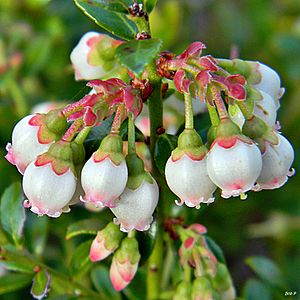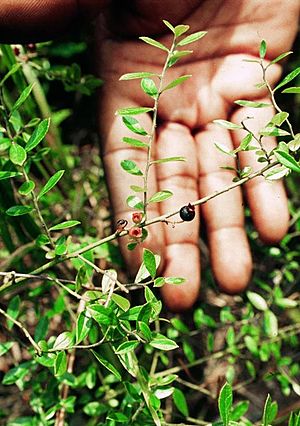Shiny blueberry facts for kids
The shiny blueberry, officially called Vaccinium myrsinites, is a cool plant from the heath family. You can find it growing naturally in the southeastern parts of the United States. This includes states like Alabama, Georgia, South Carolina, and Florida. Sometimes, it even grows as far west as Louisiana!
Quick facts for kids Shiny blueberry |
|
|---|---|
 |
|
 |
|
| Conservation status | |
| Scientific classification | |
| Synonyms | |
|
Contents
What is the Shiny Blueberry?
The shiny blueberry is a type of shrub that grows straight up and has many branches. It can reach about one meter (or 40 inches) tall. This plant is special because it has underground stems called rhizomes. These rhizomes help it spread out and form huge groups of plants called colonies. Some of these colonies have been seen to be as wide as one kilometer (about 0.63 miles) and over 1,000 years old!
Leaves, Flowers, and Fruit
Most shiny blueberry plants keep their leaves all year, meaning they are evergreen. However, some types might lose their leaves in colder seasons. The stems have green, angled twigs.
The leaves are tough and can be green or grayish-green. They are shaped like ovals and are about one centimeter (0.4 inches) long. Their edges can be smooth or have tiny teeth. The underside of the leaves feels a bit sticky because it has special glands.
The flowers look like small urns or cylinders. They are usually white, but can also be pink or have a red tint. These flowers grow in bunches of up to eight, and each flower can be almost one centimeter long.
After the flowers, the plant produces a fruit! It's a berry that is either black or a waxy blue color. These berries are about 8 or 9 millimeters long and have several small seeds inside.
Where Does the Shiny Blueberry Grow?
You can find Vaccinium myrsinites in many different places across the southeastern U.S. It likes to grow in:
- Prairies (grassy areas)
- Pine barrens (sandy areas with pine trees)
- Edges of bogs (wet, spongy ground)
- Flatwoods (flat, wooded areas)
- Florida scrub (sandy, dry areas with short trees and shrubs)
- Communities with palmetto plants
- Areas called rosemary balds
This plant can also grow in places that have been changed by humans, like areas that were recently clearcut (where all trees were removed) or old farm fields.
Plant Neighbors
The shiny blueberry often grows near other interesting plants. Some of its neighbors include:
- Scrub palmetto
- Netted pawpaw
- Scrubclover
- Dodder
- Florida blazingstar
- Scrub mint
- Tree sparkleberry
- Saw palmetto
- Lyonia
- Dwarf huckleberry
- Inkberry
- Bracken fern
- Many types of oaks
- Many types of pine trees
The best places for shiny blueberries to grow are dry, sandy spots with acidic soil and lots of sunlight.
How Does the Shiny Blueberry Reproduce?
Like many plants in the southeastern scrub, the shiny blueberry is very good at surviving fires. If a fire burns the plant above ground, it can grow back from its underground rhizomes. This is also how it forms those huge colonies of plants that are all genetically identical, like clones!
The plant also reproduces in a more traditional way, using seeds. Animals love to eat the berries, and when they do, they help spread the seeds to new places. This is called seed dispersal.
Blueberry Hybrids
Scientists believe that Vaccinium myrsinites might be a hybrid plant. This means it's a mix of two other blueberry species: the small cluster blueberry (Vaccinium tenellum) and [[Vaccinium darrowii|Darrow's evergreen blueberry].
Depending on where they grow, individual shiny blueberry plants might look more like one parent than the other. For example, plants that look more like Darrow's evergreen blueberry are common near the coast of Florida. Plants that look more like the small cluster blueberry are found in southern Georgia and northern Florida. This species can also mix with many other types of blueberries!
How People Used the Shiny Blueberry
The Seminole people, a Native American tribe, used Vaccinium myrsinites in many ways. They ate the berries for food. They also used the plant for special ceremonies and for medicine. For example, they used it to help treat a sickness they called "hog sickness," which caused people to become unconscious.
See also
 In Spanish: Vaccinium myrsinites para niños
In Spanish: Vaccinium myrsinites para niños


